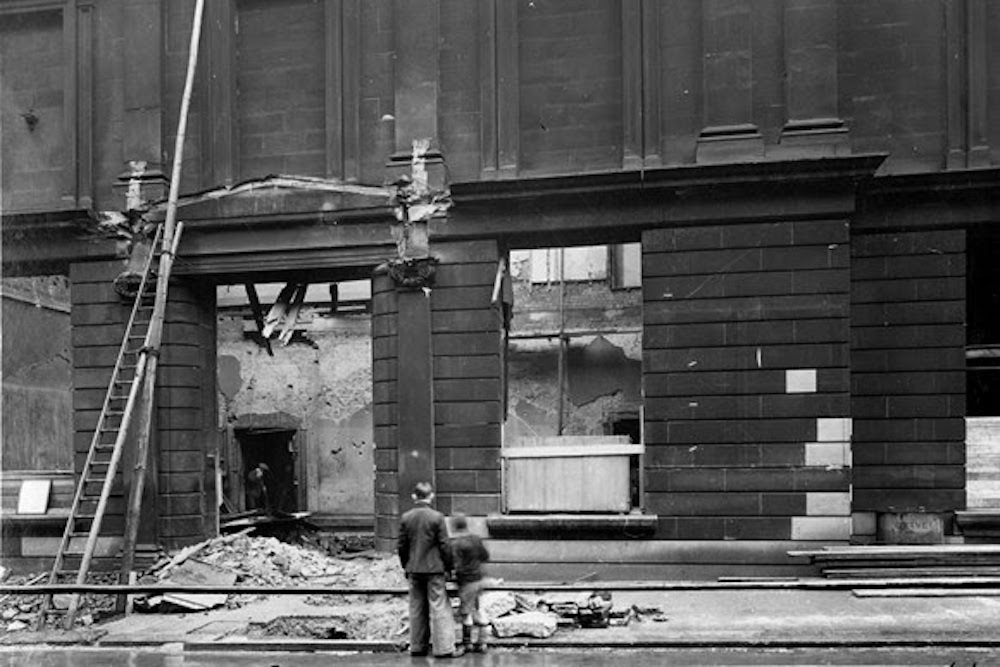
The precise locations of the high explosive bombs which fell on Leeds during its worst World War ll air raid have been mapped for the very first time by a team of students at Leeds Beckett University (LBU).
The exact sites and stories of these bombs can be seen on new webpages, which include an interactive map, that have been launched ahead of the 80th anniversary of the raid this weekend.
25 tons of explosives were dropped on the city on 14 March 1941 targeting the Gas Works and industrial areas surrounding the river Aire, but the bombs damaged many other important sites including the Town Hall, the City Museum, telephone exchange and also people’s homes. The raid caused over 100 serious fires, damaged over 4,500 buildings and resulted in 65 people losing their lives.
Although officially too small to qualify for ‘Blitz’ status (which is defined as 100 tons of explosives) the city was pounded by incendiary and high explosive bombs in two waves of attack during the night and early hours of the following morning.
Amongst the premises hit was the British Petroleum depot on Yarn Street in Hunslet which was hit by three high explosive bombs; a feed pipe was damaged resulting in the loss of 5,000 gallons of fuel oil. Various premises on Marshall Street in Holbeck were hit including the Leeds Industrial Co-operative Society (LICS) warehouse; as well as the Campbell Stewart & McDonald factory on Ingram Road in Holbeck; and a residential property on Rowland Road in Beeston Hill.
The team from the School of Cultural Studies and Humanities worked on a ‘Public History Project’ module to explore different aspects of the raid and have pinpointed the exact sites of many previously unlocated bombs.
The project was a partnership with Leeds Museums and Galleries, the Leeds Local and Family History Library and the West Yorkshire Archives Service.
Using an array of primary and secondary sources ranging from secret Home Security reports to academic texts, the Leodis photography archive, genealogy databases and historical maps the LBU group tried to uncover the full story of what had happened that night.
They also focused on the effect of the damage on civilian morale and heroism, these themes striking a balance between popular interest and historical context while also respecting and remembering those involved. Many of the stories researched happened in places still recognisable today.
Senior Lecturer in Public History Dr Henry Irving oversaw the project and said carrying it out during an unprecedented global pandemic meant the work took on an added significance:
“Though not as badly bombed as other places, we were all struck by how little had been written about Leeds. I’m really proud we have now been able to update the West Yorkshire Archive Service’s bomb map, which shows exactly where different bombs fell.
“The students also worked to connect individual incidents with the people affected, adding details about the legacies of the raid. I should also say that the subject matter was quite emotional – and, of course, we’ve had to do all of this while coping with lockdown!”
One of the groups working on the Leeds Blitz project focussed on the lives of wartime women, which resonated with BA English and History student Leanne Speight. Leanne remembered stories from her own Great Grandma who worked in a munitions factory, many of which are often little discussed:
“She was one of hundreds of thousands of women across Britain who did ‘their bit’ and it was clear she viewed her contribution as nothing out of the ordinary. But together, the women achieved something extraordinary, shattering gender stereotypes to step into traditionally male roles when the nation needed them most.
“We see clear examples of the courage demonstrated by women like my Great Grandma in the face of enemy action during the air raid on Leeds. Reports published afterwards show women did not hesitate to tackle fires caused by incendiary bombs, even when high explosives were falling nearby. Many of these women worked in roles where such actions would not have been expected of them.”
As well as a great learning outcome for the group, BA History students Bradley Danahar and Megan Guest, hope the project can help and inspire the wider public too:
“If people can also learn from the resource the group has created that will be a fantastic outcome! We also hope that understanding more about the events of 80 years ago might motivate people to help those in need right now, during another time where we must all pull together.”
This post is based on a press release issued by Leeds Beckett University
Photo credits: Leodis photographic archive who kindly provided images to accompany this story.



Very interesting project. My mother was 13 when the war started, she missed the end of school and went into a clothing factory. She worked on army uniforms. I can remember her saying how rough they were to work with. The hours were long and probably illegal for her age. She wanted to join the RAF when older and join her father and older brother also in the RAF but was told her factory work was essential. for the war effort. She appealed to a Tribunal but lost. I asked her if she was scared during the war but she said no, she knew we would win.
The clothing factory was very near the museum and she said she and her friends would go to the museum during their lunch break. She very much missed it when it was bombed.
I was glad to read about the project tonight, 15th March 2021 at 10:00 pm. I can hear the bombs now. Hope your students enjoyed the work
Born in 1944 in Domestic Street Lived with gran born 1877 Any help to anyone. It will be good to pass memories, and any photos on .1940s living with older Holbeck folk . I know all info for research should be verified if possible